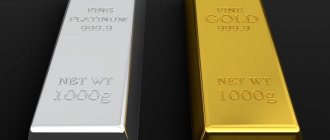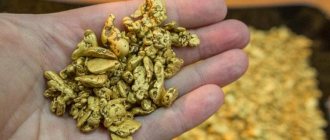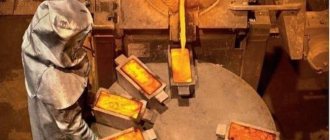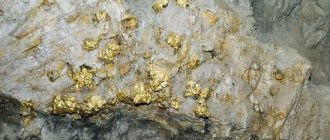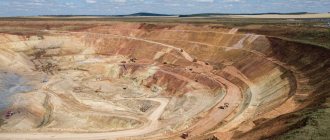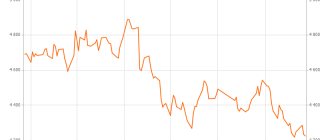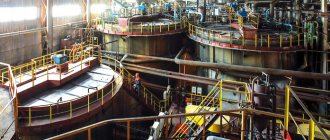Moscow, 02/28/2021, 19:53:04, editorial office PRONEDRA.RU, author Natalya Yazan.
The question of where gold is mined in Russia worries many citizens. For more than two hundred years, the map of precious metal mining sites has included more and more new objects, many of which are of the alluvial type. World experts report that over the past thirty years, the volume of production of the precious metal has been constantly changing.
At the moment, work is underway to create new methods of gold mining, in addition, dumps of mining and processing plants that produce gold as an associated material are being developed. This is the main reason that the main gold mining sites in the Russian Federation are not constant; after a while, new ones appear.
How and where gold is mined in Russia
Gold-producing countries around the world are constantly changing. For example, in the eighties, South Africa produced more than half of the world's gold, but ten years later the state's share dropped to one third. The place of Africa was taken by European countries, as well as Papua New Guinea, the Philippines, and Indonesia.
Russia mines quite a lot of this metal in different places, but not every one is useful for industry. It is worth knowing that places for industrial gold mining are divided into internal and external. The first, in turn, includes several more species.
Gold is often mined from deposits where temperatures are moderate to high, and these occur as quartz veins and sulfide stockwork zones. An important place for domestic gold mining is played by those places that were formed as a result of volcanic activity.
The most famous gold mining sites in Russia: Khakanja in the Far East, Kuranahanskoye in Aldan, the north of the Krasnoyarsk region, Khabarovsk region, Magadan and Irkutsk regions. The production level is about three hundred tons of gold annually.
Results of gold production in Russia in 2021
Supply and demand
Global gold demand fell 7% in 2021 to 4,071.7 tonnes.
The influx of gold into ETFs decreased significantly (by 63%) and amounted to 202.8 tons. The sharp decline in retail investment in the United States has reduced global demand for coins and bars. Purchases from central banks also decreased - by 5%, to 371.4 tons, the most active buyers were Russia and Turkey. The renewed demand for jewelry (an increase of 4%, to 2135.5 tons) was facilitated by purchases in India and China. The increased use of gold in smartphones and equipment led to an increase in industrial demand (by 3%, to 332.8 tons) - for the first time since 2010, demand for gold for technological needs showed positive dynamics.
Supply on the gold market in 2021 decreased by 4%, to 4398.4 tons. Production reached 3268.7 tons, while recycling of recyclable materials fell by 10%. Tightening environmental regulations in China (the world's largest producer) led to a 9% decline in gold production in the country. The global hedge portfolio decreased by 30.4 tons.
Table 1. Supply and demand on the gold market 2016-2017. (tons per year)
| 2017 | 2016 | % | |
| Offer | |||
| production | 3268,7 | 3263 | +0,2 |
| production hedging | -30,4 | +32,8 | |
| recycling | 1160 | 1295,1 | -10 |
| Total | 4398,4 | 4590,9 | -4 |
| Demand | |||
| Jewelry | 2135,5 | 2053,6 | +4 |
| Industrial | 332,8 | 323.4 | + 3 |
| Investment | 1231,9 | 1595,3 | -23 |
| -coins and bars | 1029,2 | 1048,7 | -2 |
| -ETF | 202,8 | 546,8 | -63 |
| Central banks | 371,4 | 389,8 | -5 |
| Total | 4071,7 | 4362,2 | -7 |
| Gold price (dollars per ounce) | 1257 | 1250 | |
Source: Prime with reference to WGC
China continues to hold the leading position in gold mining by a large margin. According to published data, gold mining companies in the Middle Kingdom produced about 440 tons of the yellow metal last year, recording a slight drop compared to 2021. Australia occupies second place in the ranking with 300 tons of gold production last year. The country increased its performance by 3.27%. The gold mining industry in Australia is a key industry in the country. Russia is in third place in the ranking of the world's largest gold miners with an annual production volume of 255 tons.
Table 2. Gold production in countries of the world, tons
| 2017 | 2016 | 2015 | 2014 | 2013 | 2012 | 2011 | 2010 | |
| China | 440 | 453,5 | 450 | 478 | 438 | 413 | 371 | 341 |
| Australia | 300 | 290,5 | 279,2 | 274 | 268 | 251 | 259 | 261 |
| Russia | 255* | 253,5 | 249,5 | 247 | 232 | 213 | 200 | 189 |
| USA | 245 | 236,0 | 218,2 | 209 | 230 | 231 | 233 | 231 |
| Indonesia | 80 | 168,2 | 176,3 | 116 | 111 | 89 | 120 | 140 |
| Canada | 180 | 165,0 | 159,0 | 152 | 133 | 108 | 108 | 104 |
| Peru | 155 | 164,5 | 175,9 | 173 | 188 | 180 | 188 | 185 |
| South Africa | 145 | 150 | 151 | 159 | 177 | 177 | 202 | 203 |
| Mexico | 110 | 120,5 | 135,8 | 118 | 120 | 101 | 89 | 79 |
| Ghana | 80 | 95,0 | 95,1 | 107 | 107 | 96 | 91 | 92 |
| Total in the world | 3150 | 3222 | 3208 | 3131 | 3042 | 2850 | 2829 | 2734 |
* — Extraction from mineral raw materials.
Source: 2010-2016
— magazine “Gold and Technologies”; 2021 - US Geological Survey Despite several years of declining production, Canadian mining company Barrick Gold Corporation remains an industry leader.
Barrick operates mining, exploration and development projects on four continents and has large land holdings in some of the world's richest and most promising mineral deposits. The company's vision is to be the world's best gold mining company by operating in a safe, profitable and responsible manner.
If the forecast for the current year comes true, the leader may be supplanted by Newmont Mining Corporation, a mining company from the United States. The company was founded in 1916 in New York by William Boyce Thompson as a diversified holding. Today, Newmont Mining Corporation is engaged in the development of ore deposits in various countries around the world - both independently and through ownership of shares in the authorized capital of industry companies. Unlike Barrick, Newmont's performance has been fairly stable in recent years.
AngloGold Ashanti is in third position in the ranking with a fairly significant lag. The company was formed in 2004 through the merger of AngloGold and Ashanti Goldfields Corporation. Today AngloGold has 20 projects in 10 countries on 4 continents. The majority of the company's assets are located in South Africa (43%).
Companies operating in Russia still lag quite significantly behind the leaders. There is hope that after the development of the Sukhoi Log deposit, Polyus will make a serious leap in the ranking, but it is too early to say anything concrete at this stage of development of the mine.
Table 3. Volume of gold production in leading public companies in the industry, tons
| 2013 | 2014 | 2015 | 2016 | 2017 | 2018 (forecast) | ||
| 1. | Barrick Gold, Canada | 222,9 | 194,3 | 190,2 | 171,6 | 164,8 | 155,5 |
| 2. | Newmont, USA | 157,5 | 150,7 | 156,6 | 161,7 | 161,7 | 167,9 |
| 3. | AngloGold Ashanti, South Africa | 127,5 | 138,1 | 119,1 | 112,8 | 118,2 | 105,7 |
| 4. | Goldcorp, Canada | 82,9 | 89,3 | 107,7 | 89,4 | 80,9 | 77,8 |
| 5. | Kinross Gold, Canada | 77,7 | 80,4 | 81,5 | 87,4 | 83,17 | 77,7 |
| 6. | Newcrest, Australia | 73,5 | 72,4 | 77,4 | 76,6 | 71,2 | |
| 7. | Gold Fields, South Africa | 58,1 | 69,0 | 67,2 | 66,7 | 68,4 | 65,9 |
| 8. | PJSC Polyus, Russia | 51,3 | 52,7 | 54,8 | 59,8 | 67,1 | 73,8-75,4 |
| 9. | Agnico Eagle Mines, Canada | 34,2 | 44,4 | 52,0 | 51,7 | 53,2 | |
| 10. | Sibanye Gold Ltd, South Africa | 44,5 | 49,4 | 47,8 | 47,0 | 37,1 | |
| 11. | Zijin Mining Group Co, China | 31,7 | 33,7 | 35,6 | 41,6 | 37,5 | |
| 12. | Yamana Gold, Canada | 32 | 37,2 | 39,6 | 39,4 | 25,6 | 31,4 |
| 13. | Randgold Resources Plc, UK | 28,3 | 35,7 | 37,7 | 39,0 | 40,9 | |
| 14. | Freeport-McMoRan, USA | 38,9 | 37,8 | 39,1 | 33,8 | 44,5 | |
| 15. | Harmony Gold, South Africa | 35,4 | 36,4 | 33,3 | 33,2 | 33,9 | |
| 16. | Glencore PLC, Switzerland | 31,5 | 30,6 | 29,5 | 31,9 | 62,2 | |
| 17. | Polymetal, Russia | 25 | 29,6 | 26,9 | 28,2 | 33,4 | |
| 18. | Nordgold, Russia | 29 | 30,6 | 29,5 | 27,0 | 30,1 | 29,5-31,1 |
Source: 2013-2016 — magazine “Gold and Technologies”; 2017 — company reports, media information, authors’ calculations
Exchange turnover
The main result of the year for the gold market was the metal overcoming the level of $1,300 per ounce, which allowed us to talk about a change in the previously established downward trend. The average gold price in 2017 was 1,257 per ounce, which is slightly higher (+0.4%) than in 2021.
Table 4. Average gold prices and exchange rates in 2010-2017.
| 2010 | 2011 | 2012 | 2013 | 2014 | 2015 | 2016 | 2017 | +, % | |
| Average price of gold dollars per ounce | 1224 | 1572 | 1669 | 1410 | 1266 | 1160 | 1251 | 1257 | +0,4 |
| Average price of gold rubles per gram | 1201 | 1494 | 1666 | 1435 | 1566 | 2280 | 2683 | 2357 | -12,2 |
| Average ruble to US dollar exchange rate | 30,36 | 29,39 | 31,09 | 31,2 | 38,4 | 61,4 | 66,8 | 58,34 | -12,7 |
| Ruble to US dollar exchange rate at the end of the year | 30,47 | 32,20 | 30,37 | 32,7 | 56,3 | 72,9 | 60,6 | 57,60 | -5 |
Source: 2010-2016 — magazine “Gold and Technologies”; 2017 — authors’ calculations
Figure 1. Spot gold quote daily chart of dollars per ounce
Despite the fact that gold quotes were in an upward trend for almost the entire 2021, they crossed the 200-period average for the first time, which is critical for ascertaining a change in trend, from bottom to top only in March and then repeatedly rolled back from the reached highs.
If we compare the volatility of gold with the volatility of other precious metals, it can be noted that its level was significantly lower than that of platinum and especially palladium. Gold in 2021 was not a profitable instrument for long-term investment.
Table 5. Average prices for precious metals in 2015-2017. (dollars/oz.).
| Precious metals | 2015 | 2016 | 2017 | % |
| Gold | 1160 | 1251 | 1257 | +0,4 |
| Silver | 15,68 | 17,14 | 17,05 | -0,5 |
| Platinum | 1053 | 987 | 917 | -7,1 |
| Palladium | 691,63 | 613,72 | 1014 | +65,2 |
Source: 2015-2016 — magazine “Gold and Technologies”; 2017 — authors’ calculations.
Russian Federation
According to the Ministry of Finance, gold production in Russia in 2017 amounted to 306.9 tons, which is 6% more than in 2016 (288.5 tons).
Production of mining gold increased by 6.3%, to 253.9 tons, associated gold by 11.1% to 16.4 tons, secondary gold by 4.5%, to 36.6 tons.
Table 6. Gold production in the Russian Federation in 2014-2017, kg
| 2014 | 2015 | 2016 | 2017 | |
| Dobychnoe | 230664 | 232341 | 238825 | 253900 |
| Along the way | 16240 | 16604 | 14754 | 16400 |
| Secondary | 35812 | 38474 | 35014 | 36600 |
| Total: | 282716 | 288991 | 288593 | 306900 |
Sources: 2014-2016 — magazine “Gold and Technologies”; 2017 - Ministry of Finance.
The most significant event in the Russian gold mining industry in 2017 occurred in January.
, in partnership with the Rostec state corporation, won an auction for the development of one of the largest gold deposits in the Russian Federation, Sukhoi Log.
The company also turned out to be among the stock market newsmakers: after delisting from the London Stock Exchange at the end of 2015, Polyus decided to list shares on the Moscow Stock Exchange, which attracted a wide range of investors from all over the world. The placement of shares helped the company get into the MSCI index.
At the end of May, the main shareholder of Polyus agreed to sell 10% of the company's shares to a Chinese consortium led by the Fosun investment fund for $886.9 million. The deal was to be completed by the end of 2017. The shareholders' agreement provided for a number of privileges for Fosun and its partners. They have veto power on company reorganization, liquidation, additional issue, reduction of dividend payments, transactions with related parties and buybacks. However, the deal did not take place; its termination was announced at the beginning of 2021.
In September, Vysochaishy launched the first production stage of the Taryn Mining and Processing Plant in Yakutia, and in October, the Ugakhan Mining and Processing Plant in the Irkutsk Region. Through these projects alone, the company plans to almost double its annual production volume by 2021 - up to 10 tons of gold.
Also in September, the Natalka field was launched, which a dozen years ago was considered the largest unexplored field in Russia. in 2014, she suspected something was wrong with its reserves when she did not receive the planned volume of gold when processing the first 10 million tons of ore.
It turned out that the Soviet data on the analysis of samples from the deposit were incorrect: and the information about the gold content in the ore was overestimated. In 2015, the company recalculated reserves and updated the field development model. As a result, reserve estimates were reduced by almost half. In December 2021, Polyus received the first doré bar from the deposit. It will reach full capacity at the end of this year.
In 2021, for the first time, the market started talking about a possible deal to acquire JSC Gold of Kamchatka from Renova of Viktor Vekselberg. In addition, there are grounds for renewed rumors about a possible merger of Kamchatka Gold with the Petropavlovsk company. For quite a long time, Renova increased its stake in the company, but only at the beginning of this year it joined forces with two affiliated funds, thus consolidating about 40% of the shares, and elected its candidates to the board of directors. At the same time, the founders of the company, Peter Hambro and Pavel Maslovsky, left Petropavlovsk.
In mid-March, one of the large domestic gold miners, Nordgold, after six years of public status, delisted from the London Stock Exchange. Before this, the company, which was more than 90% owned by businessman Alexei Mordashov, assessed the possibility of placing more shares on the market, but later came to the conclusion that its shares were greatly undervalued and decided to develop independently. The company continues to monitor the market and, if conditions are favorable, may return to public status after the launch of the Gross field in Yakutia in 2021.
Table 7. Gold production by companies operating in Russia, tons
| 2014 | 2015 | 2016 | 2017 | 2018 (forecast) | ||
| 1. | Polyus, PJSC | 52,66 | 54,8 | 59,82 | 67,11 | 73,8-75,41 |
| 2. | Polymetal Int.4 | 26,34 | 24,65 | 24,77 | 33,41 (44,5) | (48,2)1 |
| 3. | Kinross Gold6 | 21,31 | 21,69 | 20,69 | 83,171 (18) | 77,7 1 (15,2) |
| 4. | Yuzhuralzoloto GK, JSC | 7,28 | 12,98 | 14,55 | 153 | 153 |
| 5. | Petropavlovsk plc | 19,42 | 15,68 | 12,95 | 13,61 | 13,5-14,33 |
| 6. | Nordgold NV5 | 10,6 | 10,63 | 8,33 | 30,11 (7,38) | 29,5-31,11 |
| 7. | Highland Gold Mining | 6,71 | 6,58 | 6,92 | 8,461 | 6,7-73 |
| 8. | Gold of Kamchatka, OJSC | 1,52 | 2,34 | 5,49 | 5,173 | 5,2-5,53 |
| 9. | Vysochaishy, PJSC | 5,49 | 5,64 | 5,10 | 6,72 | 6,7-9,33 |
| 10. | Susumanzoloto, JSC | 3,97 | 4,23 | 4,53 | 5,082 | 53 |
| 11. | Seligdar, PJSC | 3,68 | 3,48 | 4,33 | 4,621 | 63 |
| 12. | Pavlik ZRK, JSC (IC "Arlan") | 0 | 1,07 | 3,66 | 6,52 | 6-6,53 |
| 13. | Zapadnaya GRK, a/s, CJSC | 2,6 | 2,88 | 3,25 | 3,093 | 3-3,23 |
| 14. | Concern "Arbat", JSC | 2,01 | 2,65 | 2,7 | 2,962 | 3,03 |
| 15. | Vitim, a/s, CJSC | 2,39 | 2,53 | 2,58 | 2,913 | 2,5-33 |
| 16. | Solovyovsky mine, JSC | 2,24 | 2,53 | 2,47 | 3,52 | 3,5-4,03 |
| 17. | Search Zoloto, JSC | 2,42 | 2,62 | 2,41 | 2,313 | 2,43 |
| 18. | Berelekh GDK, OJSC | 2,06 | 1,8 | 2,23 | 1,912 | 23 |
| 19. | Sibzoloto Holding | 1,81 | 2,383 | 2.33 | ||
| 20. | Amur Zoloto, LLC | 1,31 | 0,77 | 0,83 | 1,481 | 1,53 |
Source: 2014-2016
— “Gold and Technology” magazine. 1 – Company data 2 – Regional government data 3 – Website fomag.ru according to data from the Union of Gold Miners 4 – Gold equivalent in brackets 5 – In brackets – production at Russian divisions (estimated) 6 – In brackets – production at Russian divisions (company data)
Analyzing the regional structure of Russian gold mining, I would like to note the breakthrough of the Magadan region and the retreat of Chukotka.
In 2021, gold mining enterprises in the Magadan region produced 32,466 tons of gold, which is 19% more than the production in 2021, making the region the second largest producer of precious metals in Russia. The increase in production in the region was due to increased production at the Pavlik deposit and an increase in gold production from alluvial deposits.
Chukotka lost a quarter of its production and dropped from second place to seventh.
The decline is explained by a decrease in gold production at the Kupol, Dvoinoye and Valunistoye deposits, where there is a decrease in reserves and a decrease in gold content. Due to the decline in production, the region suffered significant budget losses.
Table 8. Gold production in Russian regions, kg
| 2012 | 2013 | 2014 | 2015 | 2016 | 2017 | % | |
| Krasnoyarsk region | 44001 | 47326 | 47236 | 49994 | 55058 | 58183 | +6 |
| Chukotka Autonomous Okrug | 17988 | 21361 | 30337 | 30548 | 28820 | 21466 | -25 |
| Magadan Region | 19587 | 21092 | 23847 | 23604 | 27314 | 32466 | +19 |
| The Republic of Sakha (Yakutia) | 20826 | 21951 | 23139 | 25344 | 23505 | 23648 | +1 |
| Amur region | 28671 | 30664 | 29312 | 25946 | 22863 | 26366 | +15 |
| Irkutsk region | 18921 | 20595 | 22112 | 22104 | 22502 | 22653 | +1 |
| Khabarovsk region | 14799 | 20416 | 20540 | 18225 | 19847 | 24410 | +23 |
| Transbaikal region | 8567 | 9452 | 9638 | 11219 | 12107 | 10822 | -11 |
| Chelyabinsk region | 5023 | 5300 | 5573 | 6742 | 7183 | 7129 | -1 |
| Kamchatka Krai | 2490 | 2214 | 2984 | 3604 | 6667 | 6377 | -4 |
| Sverdlovsk region | 7568 | 7604 | 7863 | 6411 | 6434 | 6118 | -5 |
| The Republic of Buryatia | 5989 | 5944 | 6857 | 6235 | 5988 | 5699 | -5 |
| Tyva Republic | 1425 | 1847 | 1936 | 2305 | 2371 | 1766 | -25 |
| The Republic of Khakassia | 1629 | 2199 | 2036 | 1736 | 1964 | 2192 | +12 |
| Sakhalin region | 118 | 104 | 93 | 1764 | 1582 | 1048 | -34 |
| Kemerovo region | 739 | 819 | 1008 | 1061 | 1487 | 1408 | -5 |
| Altai region | 1088 | 971 | 715 | 736 | 698 | 758 | +9 |
| Novosibirsk region | 256 | 296 | 400 | 251 | 323 | 340 | +5 |
| Altai Republic | 404 | 425 | 384 | 342 | 295 | 574 | +94 |
| Republic of Bashkortostan | 323 | 204 | 177 | 204 | 243 | 312 | +29 |
Source: 2012-2016 — magazine “Gold and Technologies”; 2017 — Assay Office
The main net buyer of domestic gold has been and remains the Central Bank of Russia. In 2021, the regulator bought about 224 tons of the precious metal, that is, approximately 73% of the volume produced in the country.
The activity of Russian commercial banks in the gold market is much more modest.
For example, reserves of precious metal in the vaults of Russian banks decreased from the beginning of September 2021 to the end of January this year by 38.5%, or by 28.2 tons, and amounted to 45 tons.
Sberbank reduced inventories during the reporting period by 13.5 tons, or 86.1%, VTB - by 13.3 tons, or 29%, Promsvyazbank - by 1.8 tons, or 93.7%.
VTB is in first place in terms of gold reserves as of February 1, 2021 (32.6 tons), Gazprombank is in second (4.1 tons), and FC Otkritie Bank is in third (2.4 tons).
Analysts note that the main buyer of gold from Russian commercial banks could be the Bank of Russia.
Table 9. Dynamics of gold purchases into the reserves of the Central Bank of the Russian Federation (2010-2017)
| date | The value of monetary gold in foreign currency (millions of US dollars) | Monetary gold (millions of fine troy ounces) | Gold reserves (tons) | Increase in reserves in tons compared to the previous year (%) |
| 01/01/2010 | 22 798 | 20,9 | 649,1 | |
| 01/01/2011 | 35 788 | 25,4 | 788,6 | 21,49 |
| 01/01/2012 | 44 697 | 28,4 | 883,0 | 11,97 |
| 01/01/2013 | 51 039 | 30,8 | 957,8 | 8,47 |
| 01/01/2014 | 39 990 | 33,3 | 1 035,2 | 8,08 |
| 01/01/2015 | 46 089,0 | 38,8 | 1 206,8 | 16,58 |
| 01/01/2016 | 48 562,6 | 45,5 | 1 415,21 | 17,27 |
| 01/01/2017 | 60 193,6 | 51,9 | 1 614,27 | 14,07 |
| 01/01/2018 | 76 647,0 | 59,1 | 1 838,22 | 13,9 |
Source: according to the Central Bank of the Russian Federation
Table 10 Dynamics of gold purchases for the reserves of the Central Bank of the Russian Federation (2017 by month)
| date | The value of monetary gold in foreign currency (millions of US dollars) | Monetary gold reserves (millions of fine troy ounces) | Gold reserves (tons)* |
| 01/01/2017 | 60 193,6 | 51,9 | 1 614,27 |
| 02/01/2017 | 62 935,7 | 52,9 | 1 645,37 |
| 03/01/2017 | 66 862,9 | 53,2 | 1 654,71 |
| 04/01/2017 | 67 569,7 | 54,0 | 1 679,59 |
| 05/01/2017 | 68 653,1 | 54,2 | 1 685,81 |
| 06/01/2017 | 69 295,3 | 54,9 | 1707,58 |
| 07/01/2017 | 68 770,2 | 55,2 | 1716,91 |
| 08/01/2017 | 70 037,5 | 55,6 | 1729,35 |
| 09/01/2017 | 73 499,6 | 56,1 | 1744,91 |
| 10/01/2017 | 73 603,5 | 57,2 | 1779,12 |
| 01.11.2017 | 73 704,9 | 57,9 | 1800,89 |
| 12/01/2017 | 76 118,2 | 58,8 | 1828,88 |
| 01/01/2018 | 76 647,0 | 59,1 | 1838,22 |
Source: according to the Central Bank of the Russian Federation
At the end of last year, Russian jewelers increased their consumption of gold for making products by 10.4% compared to 2021 - to 33.46 tons.
In total, 31.18 million pieces of jewelry containing 34.72 tons of pure gold passed through the Assay Chamber of Russia last year.
Specialists of the Assay Chamber noted that 2021 was the first year in the last few years of growth in buyer interest in gold jewelry and platinum products.
Exports of refined gold from the Russian Federation in 2021 increased by more than 2.5 times compared to 2021 and amounted to 56.6 tons.
Forecast for 2021
According to the Union of Gold Miners of Russia, gold mining and production in Russia in 2021 will increase and amount to 328 tons.
Gold production from mineral raw materials this year may increase to 293 tons due to an increase in gold production at the Natalka deposit, the Taryn and Ugakhan mining and processing plants reaching their design capacity, as well as the resumption of operation of heap leaching plants at the Birkachan deposit and the Kuranakh ore field.
Production growth will be facilitated by the extraction of the first gold at the Gross deposit, as well as the launch of a gold recovery plant at the Verkhne-Aliinsky gold deposit.
Associated gold production in 2021 may increase to 21 tons as the Bystrinsky GOK reaches its design capacity with an increase in associated gold in concentrate.
At the same time, the production of secondary gold in 2021 may decrease to 35 tons.
As for the forecast for gold prices, according to experts, two factors will influence the situation.
The first is due to the fact that current prices are not so far from the average cost of gold production ($900-1100 per ounce). This means that a number of companies are operating on the edge of profitability and overall supply may be slowly shrinking. Thus, even with constant demand, a moderate increase in quotations can be expected. The second factor will be determined by the effectiveness of Donald Trump's tax reform and the Fed's policy in general. The growing American economy can act as a powerful support.
Based on this, we can expect gold prices to be around $1,400-$1,500 per ounce.
The largest gold mining companies operating in Russia are generally positive about the prospects for 2021.
A few months ago, it revised its forecast for gold production in 2021, increasing it to 2.375 - 2.425 million ounces against the previously announced 2.35 -2.40 million. Revenue for the year is estimated at $2,684 million.
Polymetal confirmed production plans for 2021 and 2019 of 1.55 million and 1.7 million gold equivalent ounces, respectively.
Significant investments will be directed towards the completion of the Kyzyl project and the project to increase the productivity of the Amur MMC. The company also plans to accelerate the development of feasibility studies for the Nezhdaninskoye field and AGMK-2 projects.
Nordgold forecasts gold production for the current year to range from 950 thousand to 1 million ounces.
The company's capital expenditures in 2021 will be approximately $390 million, including investments in the construction of the Gross mine in Russia, exploration, development and maintenance of projects, as well as capitalized stripping activities.
The material was prepared by the editorial staff.
Published in the magazine “Gold and Technology” No. 1(39)/March 2018
Tags:
Analytics,
Gold mining results
Precious metal mining in the Ural region
One of the main places where most of Russian gold is brought to the surface is the Urals. All the necessary conditions for comfortable work are present here: climate, the presence of all important infrastructure facilities, fairly soft soil.
According to official data, gold mining in the Urals began for the first time in 1745, and by the beginning of the last century, about three hundred places for gold mining had appeared in the region. The precious metal is mined there from ore deposits and gold deposits.
In the Urals, there are two geological industrial types of deposits: vein and mineral. The largest of them are Bolshashldinskaya and Moss Swamp.
Processing plants and enterprises for the extraction of ores, crushed stone and construction sand
Processing plants (mining and processing plants, concentration factories) are mining enterprises that carry out primary processing of raw materials - solid minerals - to obtain from them products of high technical value intended for further industrial use. The feedstock processed at processing plants is:
- non-ferrous metal ore (copper, tin, copper-nickel, tungsten-molybdenum, lead-zinc, etc.);
- ferrous metal ore (iron, chrome, manganese);
- non-metallic minerals (phosphorus, graphite, potash ore, other materials);
- coal.
At enrichment plants, various processing processes are used, depending on which the following types of enterprises are distinguished:
- gravitational;
- flushing;
- magnetic enrichment;
- crushing and screening;
- flotation;
- using combined technology (including hydrometallurgy or roasting).
Depending on the location in relation to the mining enterprise (raw material base), the following types of enrichment enterprises are distinguished:
- individual – located near the raw material base (mine or shaft);
- group - created for the enrichment of raw materials extracted by a group of nearby enterprises;
- central - not geographically connected with suppliers of raw materials.
There are enrichment enterprises of vertical, horizontal and stepped type of layout. Vertical plants use a gravity-fed material transportation system. Horizontal type plants, as a rule, occupy a large industrial site, where it is possible to use an extensive mechanized transportation system. The stepped type with a gravity-mechanized transport system is most common in Russia.
The rock mass received at the processing plant is subjected to:
- crushing;
- screening;
- crushing and classification;
- basic enrichment of mineral resources, including separation of concentrates, waste, dehydration, thickening.
The finished product is delivered to bins or warehouses, from where it will be released to the consumer. Waste, which is a water-sand suspension, accumulates in dumps.
Concentrating plants are classified as enterprises with high energy intensity.
The first Russian enrichment plant, which opened in the Urals in 1760, extracted gold from ores. The theory of enrichment processes was studied by M.V. Lomonosov, who in 1763 created the scientific work “The First Foundations of Metallurgy or Ore Mining.”
Which companies own the majority of gold mining and how much do they mine?
The largest companies engaged in gold mining in Russia include:
- OJSC Polyus Gold - the company raises precious metal to the surface in the Krasnoyarsk, Irkutsk, Magadan and Amur regions. Today, the company's gold reserves are 3,000 tons.
- OJSC Severstal, this company is mainly engaged in ferrous metallurgy, however, gold mining is not in last place. Branches can be found in Russia, Kazakhstan, Ukraine, the United States, Africa and other countries.
- Almost all of the gold reserves mined in Yakutia belong to the Canadian company Kinross Gold, and in Bashkiria gold is mined by the Canadian company Highland Gold Mining Limited.
- The group mines gold in the Amur and Jewish regions, as well as in the Yamalo-Nenets Territory. Today it includes not only gold mining, but also metallurgy, the construction of various facilities, as well as scientific work.
- JSC "Polymetal" Geography of activity - enterprises in the Magadan and Sverdlovsk regions, and the Khabarovsk Territory, as well as in Chukotka and the Republic of Kazakhstan. Three development projects are currently at the construction and design stage in Karelia and Yakutia.
- OJSC Yuzhuralzoloto operates mainly in Chelyabinsk, but there are some assets in the Republic of Khakassia and the Krasnoyarsk Territory. The company works with both open and closed methods of gold mining.
- OJSC “Vysochaishy” is one of the best companies in this field, one of the ten largest in Russia.
17 largest gold miners in Russia - 2019
Top 3: family of Suleiman Kerimov - production of 88 tons for $2.97 billion, Konstantin Strukov - 33 tons for $944 million, family of Alexei Mordashov - 14 tons for $567 million
Original of this material © Forbes.ru, 03/02/2020, Precious billionaires: who owns Russian gold, Illustrations: Forbes.ru
Dmitry Yakovenko
Forbes has compiled a rating of entrepreneurs who control gold production in Russia. There are 17 names on the list. These businessmen account for about two-thirds of Russian gold production.
In 2021, according to the Union of Gold Miners, Russia produced almost 330 tons of gold. In 2021, the union predicts an increase to 340 tons. A quarter of this entire volume of precious metal is accounted for by one. It was created by billionaires Vladimir Potanin and Mikhail Prokhorov , and is now controlled by the family of billionaire Suleiman Kerimov . Polyus's closest competitor is Polymetal. It produces almost half as much gold - 41 tons versus 88 tons. Polymetal was created back in the mid-1990s by another regular on the Forbes list - industrialist Alexander Nesis - today he is the company's largest shareholder.
Who owns the other largest gold mining companies? Forbes has compiled the first rating of Russian gold miners. We expressed gold production by the largest Russian companies in US dollars, using the average exchange price of gold in 2019 - $1,392 per ounce. We then divided this indicator for each company in proportion to the blocks of shares owned by its main shareholders. In fact, the rating demonstrates what share of companies' revenue from the sale of gold comes from the owners. An important caveat is that this is an average. After all, the selling price of produced gold may differ from the exchange price. It may be higher if gold is sold through banks with a commission (can reach 0.5-1%), it may be lower if gold is sold not in bullion from refineries, but in the form of concentrate. In 2017 and 2018, 10-15 tons of Russian gold were sold in the form of concentrate.
The rating included 17 entrepreneurs. Among them are nine members of the Forbes list. These businessmen control 11 companies that produce almost 64% of Russian gold. The first place was predictably taken by the family of Suleiman Kerimov - Polyus shares (about 78%) belong to his son, 24-year-old Said. And Alexander Nesis took only fourth place - although Polymetal is second only to Polyus in terms of the volume of gold mined, the share of Nesis's ICT group in the company is only 27%. As a result, the second place in the ranking was taken by former prospector and founder of Yuzhuralzoloto Konstantin Strukov , who recently expanded his gold empire by purchasing 28% of the Amur company Petropavlovsk from billionaire Roman Trotsenko and becoming its largest shareholder.
***
Family of Suleiman Kerimov
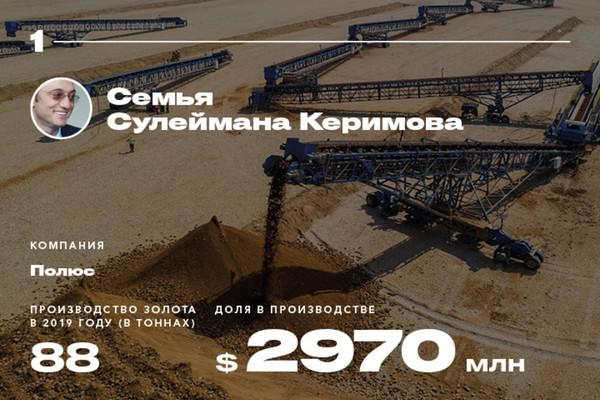
Share in gold production: $2970 million
Suleiman Kerimov’s first experience of entering gold mining occurred in 2005, when he bought Alexander Nesis (Polymetal) from the ICT group for $900 million. The Dagestan billionaire did not remain a gold miner for long - he brought Polymetal to an IPO and already in the summer of 2007 he sold the remaining 70% of his shares back to Nesis, as well as to the Czech PPF group and Alexander Mamut . At the time, this package was worth $1.8 billion on the stock exchange.
Soon Kerimov returned to gold mining. In 2009, Vladimir Potanin’s Interros holding, which sank during the crisis, really needed money to pay its debts, and he decided to sell a 39% stake in Polyus Gold, created on the basis of the gold mining assets of Norilsk Nickel. The company already took first place in gold production in Russia at that time - about 40 tons per year. Kerimov was the buyer, he paid Potanin $1.3 billion. Today, the Kerimov family’s share in Polyus (as the company was renamed in 2021) is about 78% of the company - this is its largest asset. Formally, the shares belong to Kerimov’s son, 24-year-old Said. Polyus retained its status as the largest gold miner in Russia. In 2021, a joint venture between Rostec and Polyus won an auction for the right to develop Sukhoi Log, Russia’s largest gold and silver deposit.
***
Konstantin Strukov
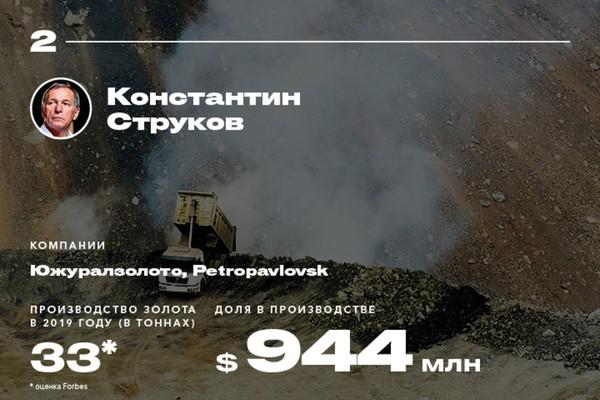
, Petropavlovsk
Share in gold production: $944 million
In the early 1990s, former prospector Konstantin Strukov moved from Kazakhstan to the Chelyabinsk region to start gold mining almost single-handedly. In the town of Plast, he rented a flooded mine, restored work and began mining. Soon he was joined by former colleagues from the artel in Kazakhstan. Today, Strukov’s Yuzhuralzoloto, with assets in Transbaikalia, the Krasnoyarsk Territory and the Chelyabinsk Region, is the third gold miner in Russia after Polyus and Polymetal. In 2021, the company produced almost 18 tons of gold.
In 2021, the gold empire of billionaire Strukov has increased. Yuzhuralzoloto bought from Roman Trotsenko F 59's AEON group almost 28% of the shares of Petropavlovsk, the fifth largest gold mining company in Russia by production volume with key assets in the Amur region. Trotsenko bought this stake just six months before the deal with Strukov from Kazakh businessman Kenes Rakishev . Viktor Vekselberg’s Renova .
Read how Strukov became one of the largest gold miners in Russia in the material “A Simple Prospector. Why did the owner of Yuzhuralzoloto need Moscow?”
***
Family of Alexey Mordashov
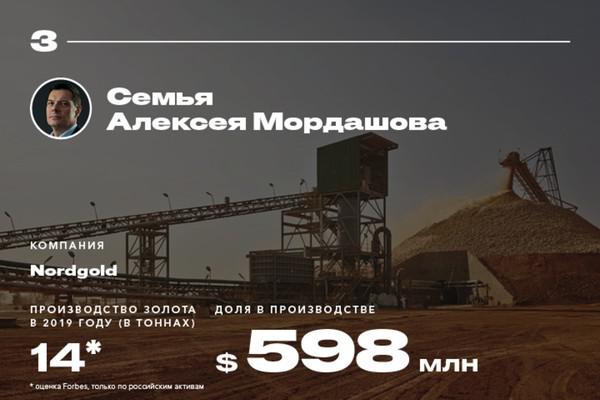
Company: Nordgold
Share in gold production: $567 million
In 2007, Severstal, owned by Alexei Mordashov, began actively purchasing gold mining assets around the world. In 2012, Severstal's gold mining division spun off into a separate company, Nordgold, and placed depositary receipts on the London Stock Exchange. Today the company has operating mines and yet-to-be-launched projects in Russia, Kazakhstan, Burkina Faso, Guinea, French Guiana and Canada. Russia accounts for just over 40% of gold production. According to Forbes estimates, in 2021, gold production at Nordgold's Russian enterprises increased by 60%, thanks to the launch of the Gross mine in Yakutia in 2021.
In 2021, Mordashov transferred part of the Nordgold shares to his sons, Kirill and Nikita. As a result, the brothers' effective share in Nordgold is 64.961%, their father's is 34.979%. The remaining shares belong to management.
***
Alexander Nesis and partners
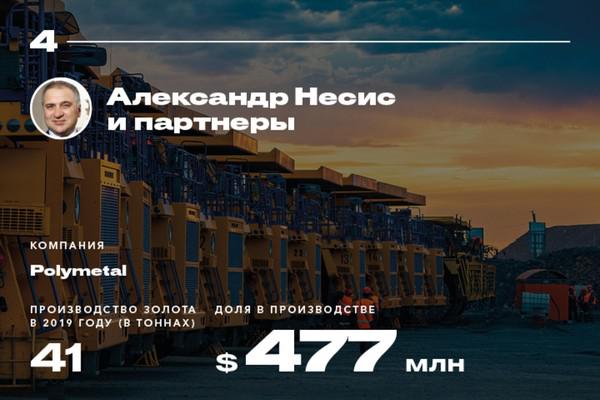
Company: Polymetal
Share in gold production: $477 million
In 1997, the ICT group of Alexander Nesis sold shares of the Baltic Plant in St. Petersburg to Vladimir Potanin’s Interros, and with the money they earned began buying gold and silver deposits over a vast territory from the Urals to the Far East. In 2003, Nesis entrusted the management of these assets, united into (today Polymetal), to his brother Vitaly. “It may sound a little immodest, but what I respect myself for is Polymetal,” the businessman said in a 2004 interview with Forbes. A year later, Alexander Nesis said goodbye to the object of his pride, selling shares of Polymetal to the structures of Suleiman Kerimov. But not for long - already in 2008, the IST group, together with the Czech PPF of Petr Kellner and Alexander Mamut, bought the shares of the gold miner back. “Yes, at some point it seemed to Nesis that the Polymetal project was finished, his mission as a developer was completed - the cost of Polymetal had reached the coveted billion. That's why he monetized this story. And then the prices of gold and silver rose in a way that no one could have predicted,” Mamut explained the logic of the return.
Today Polymetal is the second gold producer in Russia and the largest silver producer. ICT Group is the largest shareholder, owning 27% of the shares. Mamut and Kellner did not make it into the top ten in the ranking of gold miners. PPF's share is now 6.5%, Mamut's is less than 3%.
***
Iskander Makhmudov, Andrey Bokarev and Andrey Kozitsyn

Company: UMMC
Share in gold production: $367 million
Andrey Kozitsyn, general director and co-owner of the Ural Mining and Metallurgical Company (UMMC) in 2021 . UMMC produces much more impressive volumes of gold from sludge, waste generated during the production of other metals, such as copper and nickel. This is done by the Uralelectromed enterprise, part of UMMC and located near Yekaterinburg. In 2006, Uralelectromed gold received Good Delivery status - an approved supplier on the London Precious Metals Exchange. UMMC also includes the Gaisky Mining and Processing Plant located in the Orenburg region, which extracts gold from polymetallic ores.
UMMC does not disclose the exact volumes of gold production. In 2016, precious metals as a whole brought the company 9% of revenue (total $5.3 billion). UMMC estimated its share in the production of Russian gold at 4%, silver at 12%.
***
Arkady Bolshakov and partners
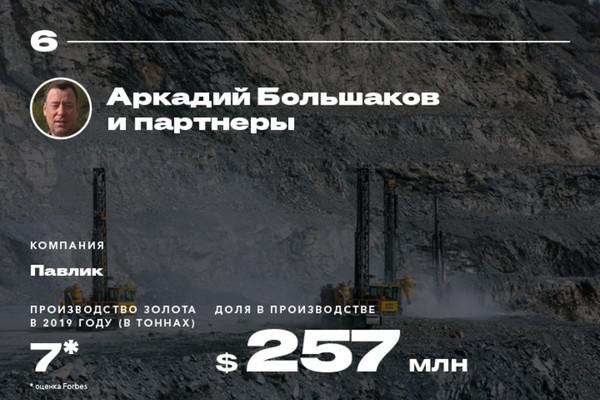
Share in gold production: $257 million
One of the most non-public participants in the rating, the Arlan group, in the early 2000s was one of the key suppliers of aluminum for AvtoVAZ, in partnership with which it took part in the privatization of the Zaporozhye Aluminum Plant. Arlan had investments in real estate, agriculture, Internet startups (the group was one of the investors in Oscar Hartman's KupiVIP) and even in African diamonds and Namibian uranium. But the group's largest projects were in gold mining. In 2007, the group began to develop several fields in the Magadan region, the largest of which is Pavlik, located next to Natalka, one of Polyus’ key assets. The first gold was mined at the Pavlik mining and processing complex in 2015.
The ownership structure of Arlan has never been disclosed. As Kommersant wrote in the mid-2000s, Arlan was controlled by AvtoVAZ top managers. One of the group’s projects is the Zolotaya Niva livestock complex; its main shareholder is the president of the Arlan group, Arkady Bolshakov. Bolshakov and his partners are key shareholders of Arlan, a source close to the group told Forbes. In the spring of 2021, Gazprombank entered into the capital of Pavlik.
***
Sergei Dokuchaev, Natalya Opaleva and Valerian Tikhonov

Company: GV Gold
Share in gold production: $214 million
History) began in 1997, when the owner of Lanta Bank, which worked with refineries and gold mining cooperatives, Sergei Dokuchaev, decided to become a gold miner. They started building a business on the basis of the Golets Vysochaishy deposit in the Irkutsk region. Project financing for the future GV Gold was handled by Lanta Bank employee Natalya Opaleva, who received a share in the business. Today Opaleva, with an estimated net worth of $340 million, occupies 11th place in the ranking of the richest women in Russia. She owns 20.36% of the shares of Vysochaishy; Dokuchaev and his longtime friend Valerian Tikhonov own the same blocks. At the end of 2021, GV Gold received record revenue of $361 million. In 2021, Bloomberg reported that the Chinese Fosun was interested in a majority stake in GV Gold. But the deal fell apart - according to RBC sources, the parties did not agree on the price.
Read more about the history of GV Gold in the material “Golden Hands. How Natalia Opaleva combines many professions.”
***
Victor Vekselberg

Share in gold production: $208 million
A veteran of the corporate wars of the 1990s, Viktor Vekselberg took part in the battle for the Petropavlovsk company in 2017 with its founders Peter Hambro and Pavel Maslovsky. Vekselberg’s Renova at that time belonged to the company, which the billionaire built in the 2000s together with businessman Mark Buzuk. Renova began buying shares and bonds of Petropavlovsk in 2015. Vekselberg’s plans were to unite and create one of the leaders in gold mining - consolidation with Highland Gold, GV Gold and Musa Bazhaev’s . In the summer of 2021, Renova managed to squeeze both Hambro and Maslovsky out of the company, but instead of creating a major player, Vekselberg decided to sell gold mining assets separately. In December, Renova sold a stake in Petropavlovsk (22.18% shares) to Kenes Rakishev and agreed to sell Kamchatka Gold with GV Gold. But the deal, which was valued at $500 million, fell apart in April 2021 after the United States imposed sanctions on Vekselberg.
***
Vladimir Hristov
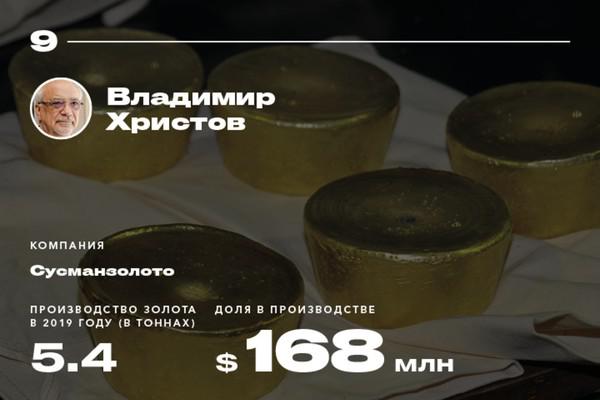
Share in gold production: $168 million
Vladimir Khristov , who grew up on the Sea of Azov in a fishing family, was prompted to move to the Far East by Vasily Aksenov’s stories about the life of Soviet youth, published in the 1960s in the magazine “Yunost”. He ended up in the city of Susuman, located 600 km from Magadan, where he got a job at a gold mine. When perestroika began, Khristov worked as chief engineer at the Susumansky GOK. In the mid-1990s, he took part in the privatization, which united the mining and processing plant and several other enterprises and cooperatives. Today Khristov is the main shareholder of Susumanzoloto. Since 1990, the gold miner has been elected to the Magadan Regional Duma several times. At the end of 2018, Susumanzoloto increased revenue by 21%, to 16.2 billion rubles.
***
Evgeny Shvidler, Roman Abramovich, David Davidovich and Valery Oif

Company: Highland Gold
Share in gold production: $122 million
Roman Abramovich in gold in 2007, when he was still in charge of Chukotka . The Millhouse company, which manages the assets of the billionaire and his partners, began investing in gold mining with the purchase of the Dvoinoye deposit in Chukotka. Several more deposits followed, but the main purchase was a 40% stake in the Russian-British company Highland Gold, for which Millhouse paid $400 million at the end of 2007. This company was well known to Abramovich: among its founders in 2002 was a former board member Directors of Sibneft Ivan Kulakov. In addition, one of Highland Gold's largest assets was the Chukotka Mayskoye deposit. In 2008, Abramovich’s long-time associate Valery Oif ; in 1997-2004, he worked as vice president of Sibneft. Today Oif owns 4.5% of Highland Gold. In total, Abramovich and his three associates in Sibneft ( Evgeny Shvidler , David Davidovich and Valery Oif) own 30.33% of the shares.

